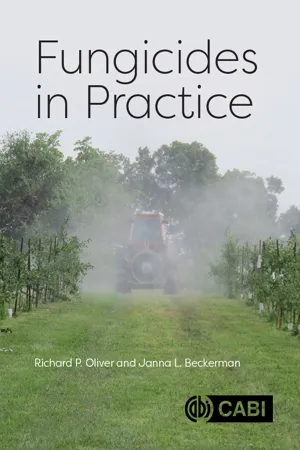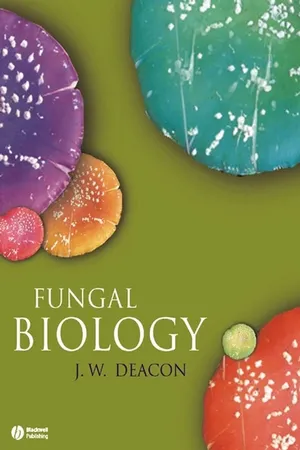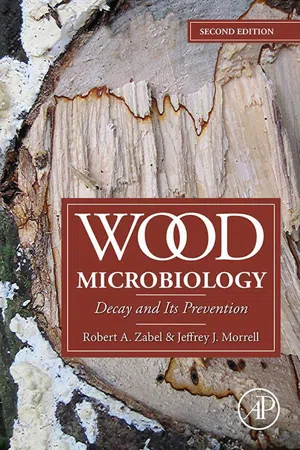Biological Sciences
Oomycetes
Oomycetes are a group of fungus-like microorganisms that were once classified as fungi but are now recognized as belonging to a distinct lineage. They are known for causing plant diseases, such as late blight in potatoes and downy mildew in grapes. Oomycetes have a significant impact on agriculture and ecosystems due to their pathogenic nature.
Written by Perlego with AI-assistance
4 Key excerpts on "Oomycetes"
- eBook - ePub
- Richard P. Oliver, Janna L Beckerman(Authors)
- 2022(Publication Date)
- CAB International(Publisher)
This group includes several highly destructive and historically significant pathogens. The most famous example is the potato late blight pathogen Phytophthora infestans that triggered the great 1845 Irish potato famine; it still causes major losses today and is a major target for fungicide development. The other two groups are Pythiales and Peronosporales. Pythium species are the cause of seedling damping-off diseases, whereas the Peronospora cause the downy mildews. The diseases caused by Oomycota include many that can be described as biotrophic, such as the downy mildews, as well as hemibiotrophic interactions, such as those caused by the Phytophthora group. At first glance, these three groups share many of the features of fungi. They are eukaryotic, heterotrophic, acquire nutrients only by adsorption and grow by filamentous expansion. They cause diseases with mildew, blight or rot symptoms just like fungi. However, there are also obvious differences. They have motile spores that use flagella. They lack chitin and ergosterol and instead have cellulose-reinforced cell walls with phytosterols in their cell membranes. And importantly, most of the fungicides that work against Oomycetes do not control fungi and vice versa. These differences were resolved once molecular phylogenetic data were applied to eukaryotic taxa (Forster et al., 1990). These data clearly showed that Oomycetes were completely unrelated to fungi. Indeed, fungi share a common ancestor with animals and if anything, Oomycetes share more common features with plants. Plasmodiophora A common root disease of brassica crops called clubroot is caused by Plasmodiophora brassicae. This organism has been placed into a distant taxon, the Rhizaria. It was previously known as a slime mould and placed with the ‘protists’ - eBook - ePub
- J. W. Deacon(Author)
- 2013(Publication Date)
- Wiley-Blackwell(Publisher)
Fig. 2.33 Some representative methods of conidium production in mitosporic fungi.The fungus-like organisms
In addition to the true fungi, several fungus-like organisms have traditionally been studied by mycologists. This legacy dates back a long time and it is defensible, so long as we recognize that the fungus-like organisms are not true fungi. The main fungus-like organisms that can be considered as fungi in a broader sense (Box 2.1 ) are:- The Oomycota, which belong to the Kingdom Straminipila (stramenipiles; Dick 2001) and are closely related to the golden-brown algae and diatoms.
- The acrasid and dictyostelid slime moulds (Acrasiomycota and Dictyosteliomycota).
- The plasmodial slime moulds (Myxomycota).
- The plasmodiophorids (Plasmodiophoromycota).
The Oomycota
The Oomycota are the most economically important fungus-like organisms and play extremely significant roles in many environmental processes. They are particularly important as plant pathogens, and cause some of the most devastating plant diseases, such as potato blight (caused by Phytophthora infestans ), sudden oak death (caused by Phytophthora ramorum ), many seedling and “decline” diseases caused by Pythium spp., and several downy mildew diseases. These diseases are treated in detail in Chapter 14. Many other aspects of the Oomycota are covered in Chapters 3 and 10.One of the most remarkable features of Oomycota is that they behave exactly like the true fungi. Their hyphae exhibit apical growth and penetrate plant cells by producing cell-wall-degrading enzymes. They also use similar infection strategies to those of fungi. So, by a remarkable degree of convergent evolution the Oomycota have developed a lifestyle equivalent to that of fungi (Latijnhouwers et al. - eBook - ePub
Wood Microbiology
Decay and Its Prevention
- Robert A. Zabel, Jeffrey J. Morrell(Authors)
- 2020(Publication Date)
- Academic Press(Publisher)
Early classifications of wood-decay fungi were based on convenient macroscopic characters such as the size and shape of the fruiting structures and the nature of the surfaces bearing the hymenium (tubes, gills, spines, smooth, etc.). The limited fossil record of fungi made it difficult to suggest phylogenetic relationships. Another great difficulty was the evolutionary phenomena of convergence, where macroscopically similar fungi sometimes have very different origins. The result was a classification system based upon fruiting body features such as smooth, poroid, toothed or other arrangements of the hymenium that placed many similar looking, but phylogenetically distant organisms into the same groups. Techniques for assessing differences in DNA and RNA have markedly enhanced the ability to delineate between direct genetic connections and convergence.Major revisions in the classifications of many groups will continue as new information on the microscopic, ultrastructural, physiologic, genetic and biochemical features of fungi accumulates. Similar changes are occurring in the classifications of the bacteria.The general classification scheme we will use for fungi is in the current edition of the “Ainsworth & Bisby’s Dictionary of Fungi” (Kerk et al., 2009). Emphasis in this section will be placed on the groups of fungi that inhabit, modify, or destroy wood. Drastic taxonomic revisions have occurred in all groups of fungi and will continue to occur as researchers examine the genetic basis for many groups.Fungi are placed in a single group, the Eumycota, and are considered to have a common ancestor. One current classification scheme lists 7 Phyla within the Fungi: Microsporidia, Chytridiomycota, Blastocladiomycota, Neocallimastigomycota, Glomeromycota, Ascomycota, and Basidiomycota. Mycosporidia are internal parasites of other organisms and will not be considered here.Chytridiomycota are often called chytrids are distinctive because they produce motile zoospores with a single flagellum. They are not important in wood degradation, but they have recently been implicated in a number of high-profile animal diseases notably with bats and many amphibians. Like the chytrids, Blastocladiomycota and Neocallimastigomycota produce motile zoospores, but primarily feed on decaying organic matter. The latter group lives in anaerobic environments including the digestive systems of many herbivores or other extreme environments where oxygen is limited. These groups, while important in other applications are not considered to be wood degraders. - eBook - ePub
- Thomas N Taylor, Michael Krings, Edith L. Taylor(Authors)
- 2014(Publication Date)
- Academic Press(Publisher)
Dick, 2001 ).The Peronosporomycetes today comprise approximately 500–800 species that thrive in both aquatic (marine and freshwater) and terrestrial environments, where they function as saprotrophs and disease causative agents in plants (including algae), animals, and even humans (e.g. Margulis and Schwartz, 1998 ; Jiang and Tyler, 2012 ). Within the group are economically important and biologically sophisticated phytopathogens, including the root-rotting fungi and downy mildews (e.g. Kamoun, 2003 ; Govers and Gijzen, 2006 ; Bozkurt et al., 2012 ). One form, Phytophthora infestans , significantly influenced human history as the causative agent of the disease called late blight or potato blight. An epidemic of late blight was responsible for the Great Famine in Ireland (1845–1852) and the resultant major decline in the population through starvation and emigration (Gregory, 1983 ; Mizubuti and Fry, 2006 ).Although phylogenetically distant, plant-parasitizing peronosporomycetes and fungi share a unique capability compared with other microbial pathogens; that is, they are able to breach the cuticle of the host plant and rapidly establish infection (Soanes et al., 2007 ; Meng et al., 2009 ). It has been suggested that the success of some peronosporomycetes as plant pathogens is due in part to acquisition of genes from fungi through horizontal gene transfer (e.g. Richards et al., 2011 ).Fossil Peronosporomycetes
The Peronosporomycetes are hypothesized to have evolved in the marine realm from a photosynthetic ancestor through the loss of plastids and acquisition of a parasitic or saprotrophic life history biology (Beakes and Sekimoto, 2009 ; Grenville-Briggs et al., 2011 ; Beakes et al., 2012 ; Seidl et al., 2012 ). However, the evolutionary patterns leading to the present-day diversity of this group remain incompletely understood, in part because molecular markers that might reveal deep phylogenetic patterns are lacking (Lara and Belbahri, 2011 ). The earliest diverging genera are thought to be Eurychasma and Haptoglossa , both obligate parasites (e.g. Johnson and Sparrow, 1961 ; Davidson and Barron, 1973 ; Küpper et al., 2006 ; Strittmatter et al., 2009 ; Grenville-Briggs et al., 2011 ). Oogamous sexual reproduction, regarded as one of the major evolutionary innovations that defines crown Oomycetes, may have developed after migration from the sea to land (Beakes et al., 2012
Index pages curate the most relevant extracts from our library of academic textbooks. They’ve been created using an in-house natural language model (NLM), each adding context and meaning to key research topics.
Explore more topic indexes
Explore more topic indexes
1 of 6
Explore more topic indexes
1 of 4



